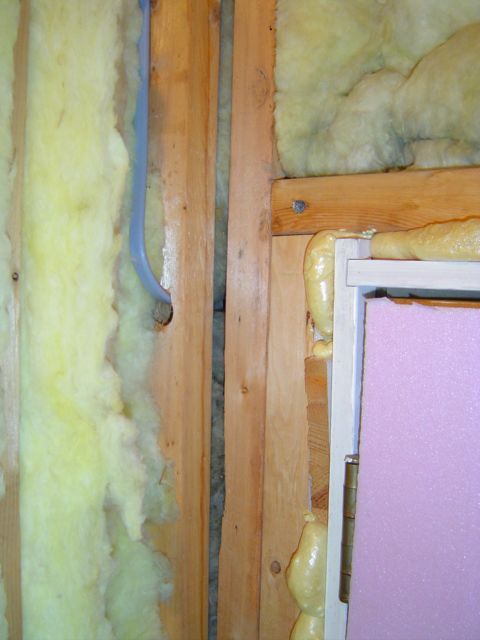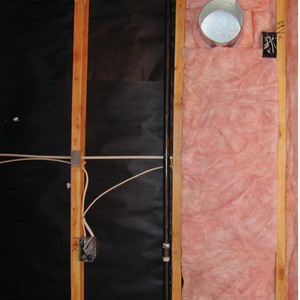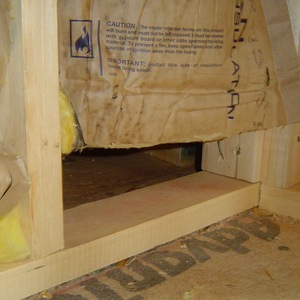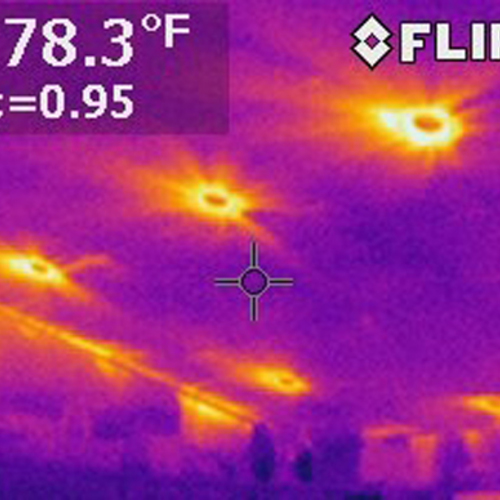Image Credit: Energy Vanguard
Image Credit: Energy Vanguard Here's more dirty fiberglass insulation. Is the problem with the fiberglass? Or could it be the huge hole in the ceiling of this home?
Image Credit: Energy Vanguard When fiberglass insulation is installed properly and is aligned with a good air barrier, it can work as well as any other insulation.
Image Credit: Energy Vanguard
I read a lot of stuff online about insulation and air barriers and other building science topics. I see a fair number of articles bashing certain products or materials. Sometimes it’s because the author sells a competing product. Sometimes they just don’t like a product. Take fiberglass insulation, for example. What thoughts just went through your head?
Those who have some building science training will look at the photo on the right and immediately see the symptom of a problem. The places where that formerly yellow fiberglass insulation has turned dark grey are places where air is moving through the fiberglass.
Some people will jump from that symptom straight to a guilty verdict for fiberglass. Sometimes they’ll even deridingly call it “filterglass” because it doesn’t stop the air from moving through it.
But is the type of insulation really the source of the problem here?
What about the next photo (Image #2, below)? It’s another case where the light-colored insulation has turned dark by picking up dirt from the air moving through it. Is the problem that they used an air-permeable insulation material?
Or could it be that there’s a huge hole in the ceiling? Seal the hole and the fiberglass will perform a lot better. When you think in terms of building enclosure control layers, it’s a lot easier to assign the blame correctly.
A good building will have control layers that control the flows of heat, air, and moisture. Just because a failure in the air control layer (air barrier) shows up in the heat control layer (insulation) doesn’t mean it’s the fault of the insulation.
Hey, I’ve bashed fiberglass in the Energy Vanguard Blog. I wasn’t condemning it as a product, though; the way it often gets installed is what irked me. (I heard from one of the manufacturers about that article, but that’s a whole other story.)
But fiberglass and other air-permeable insulation can work just fine. It can be installed well, too. The last photo below is a perfect example of a Grade 1 installation I saw in Nashville a few years ago. When put in contact with a good air barrier, it will work just fine.
Everyone has their preferences, and that’s OK. But if you’re going to argue against a product, make sure you’re using valid arguments. Dirt showing in fiberglass insulation isn’t a valid reason to convict fiberglass.
Allison Bailes of Decatur, Georgia, is a speaker, writer, energy consultant, RESNET-certified trainer, and the author of the Energy Vanguard Blog. Check out his in-depth course, Mastering Building Science at Heatspring Learning Institute, and follow him on Twitter at @EnergyVanguard.
Weekly Newsletter
Get building science and energy efficiency advice, plus special offers, in your inbox.
















2 Comments
"worse than studs"
I once had a contractor tell me that fiberglass was so bad in cold weather, that the studs insulate better than the fiberglass-fill cavities between them. He claimed to have seen a thermal image that proved that. I suspect it was a thermal image of an uninsulated wall. Perhaps somebody selling some other kind of insulation claimed it was an image of a fiberglass-insulated wall.
Fiberglass is not my favorite kind of insulation, but somehow its faults seem to get exaggerated rather wildly.
Dirty Fiberglass
"Dirt showing in fiberglass insulation isn't a valid reason to convict fiberglass" - Heck, that's a strength of fiberglass! It's a handy infiltration indicator for retrofit work.
Log in or create an account to post a comment.
Sign up Log in